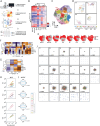Profiling Dynamic Patterns of Single-Cell Motility
- PMID: 39136147
- PMCID: PMC11481225
- DOI: 10.1002/advs.202400918
Profiling Dynamic Patterns of Single-Cell Motility
Abstract
Cell motility plays an essential role in many biological processes as cells move and interact within their local microenvironments. Current methods for quantifying cell motility typically involve tracking individual cells over time, but the results are often presented as averaged values across cell populations. While informative, these ensemble approaches have limitations in assessing cellular heterogeneity and identifying generalizable patterns of single-cell behaviors, at baseline and in response to perturbations. In this study, CaMI is introduced, a computational framework designed to leverage the single-cell nature of motility data. CaMI identifies and classifies distinct spatio-temporal behaviors of individual cells, enabling robust classification of single-cell motility patterns in a large dataset (n = 74 253 cells). This framework allows quantification of spatial and temporal heterogeneities, determination of single-cell motility behaviors across various biological conditions and provides a visualization scheme for direct interpretation of dynamic cell behaviors. Importantly, CaMI reveals insights that conventional cell motility analyses may overlook, showcasing its utility in uncovering robust biological insights. Together, a multivariate framework is presented to classify emergent patterns of single-cell motility, emphasizing the critical role of cellular heterogeneity in shaping cell behaviors across populations.
Keywords: cell motility; high‐throughput cell phenotyping; single‐cell behaviors.
© 2024 The Author(s). Advanced Science published by Wiley‐VCH GmbH.
Conflict of interest statement
D.M. and J.M.P. are co‐inventors on a patent application related to this work. All other authors declare no other conflicts of interest.
Figures





References
-
- Crainiciuc G., Palomino‐Segura M., Molina‐Moreno M., Sicilia J., Aragones D. G., Li J. L. Y., Madurga R., Adrover J. M., Aroca‐Crevillén A., Martin‐Salamanca S., del Valle A. S., Castillo S. D., Welch H. C. E., Soehnlein O., Graupera M. Sánchez‐Cabo F., Zarbock A., Smithgall T. E. Di Pilato M., Mempel T. R., Tharaux P. L., González S. F., Ayuso‐Sacido A., Ng L. G., Calvo G. F., González‐Díaz I., Díaz‐de‐María F., Hidalgo A., Nature 2022, 601, 415. - PMC - PubMed
-
- Efremova M., Teichmann S. A., Nat. Methods 2020, 17, 14. - PubMed
MeSH terms
Grants and funding
LinkOut - more resources
Full Text Sources
